Numerical Modelling of the Effect of Filler/Matrix Interfacial Strength on the Fracture of Cementitious Composites
Abstract
1. Introduction
2. Approach
2.1. Generation of Microstrocture
2.2. Construction of Lattice Structure
2.3. Fracture Process Simulation
2.3.1. Numerical Approach
2.3.2. Geometry and Boundary Conditions
2.3.3. Fracture Law
2.4. Mesh Sensitivity
2.5. Material Parameters
3. Results and Discussion
3.1. Effect of Filler Distribution
3.2. Effect of Filler Size
3.3. Effect of Filler Shape
3.4. Effect of Surface Roughness of Filler Particles
3.5. Effect of Filler Area Fraction
4. Conclusions
4.1. Strength of Cement Paste Specimens with a Weak Filler-Matrix Interface
- Randomly-distributed filler particles can decrease the strength of cement paste due to the aggregation of filler particles, which facilitates the connection of cracks and the final damage.
- In the investigated range of particle size of the filler (5 µm, 10 µm, 15 µm and 20 µm), the influence of the particle size on the strength of specimens is not noticeable.
- The sharp edges of the polygonal particle shape are not favorable for initiation of cracks, which leads to the concentration of cracking. Besides, the sharp edges of the polygonal particle shape also cause the stress concentration, which makes the specimen easily crack. Consequently, both the strength and the strain at peak stress of the specimens with circular filler particles are much higher than those with arbitrary polygonal filler particles.
- With increasing surface roughness, the strength of the specimens increases because the rougher surface makes initial cracks harder to connect and to cause final damage.
- With increasing filler content, the strength of the specimens decreases due to the increase of weak filler-matrix interfaces, which promotes propagation of cracks and hence reduces the strength of the cement paste specimens.
4.2. Strength of Cement Paste Specimens with a Strong Filler-Matrix Interface
- The particle distribution has an influence on the strength of specimens, but the influence is not remarkable. The strength of specimens with uniformly-distributed filler particles is only a little higher than that of specimens with randomly-distributed filler particles.
- In the case of the specimens with uniformly-distributed filler particles, the influence of the particle size on the strength of specimens is small. However, in the case of specimens with randomly-distributed filler particles, the strength decreases with increasing filler particle size.
- The particle shape, roughness and content of filler have little effect on the strength of specimens.
- The influence of particle distribution, size, shape, surface roughness and area fraction of filler on the strength of the specimens with a strong interface is much smaller than on the strength of the specimens with weak interface.
4.3. Micro-Crack Pattern
- With a weak interface, the crack patterns appear different, especially the number of independent cracks.
- With a strong interface, the crack patterns appear similar regardless of the particle distribution, size, shape, surface roughness and area fraction of filler, although the location of the main cracks may change.
- The micro-crack patterns of the cement paste specimens with a strong filler-matrix interface are very different from those of the specimens with a weak filler-matrix interface.
Authors Contributions
Funding
Acknowledgments
Conflicts of Interest
References
- Bonavetti, V.; Donza, H.; Menendez, G.; Cabrera, O.; Irassar, E.F. Limestone filler cement in low w/c concrete: A rational use of energy. Cem. Concr. Res. 2003, 33, 865–871. [Google Scholar] [CrossRef]
- Nehdi, M.; Mindess, S.; Aitcin, P.C. Optimization of high strength limestone filler cement mortars. Cem. Concr. Res. 1996, 26, 883–893. [Google Scholar] [CrossRef]
- Justnes, H.; Dahl, P.A.; Ronin, V.; Jonasson, J.E.; Elfgren, L. Microstructure and performance of energetically modified cement (EMC) with high filler content. Cem. Concr. Compos. 2007, 29, 533–541. [Google Scholar] [CrossRef]
- Lothenbach, B.; Le Saout, G.; Gallucci, E.; Scrivener, K. Influence of limestone on the hydration of Portland cements. Cem Concr. Res. 2008, 38, 848–860. [Google Scholar] [CrossRef]
- Bentz, D.P. Modeling the influence of limestone filler on cement hydration using CEMHYD3D. Cem. Concr. Compos. 2006, 28, 124–129. [Google Scholar] [CrossRef]
- Moosberg-Bustnes, H.; Lagerblad, B.; Forssberg, E. The function of fillers in concrete. Mat. Struct. 2004, 37, 74–81. [Google Scholar] [CrossRef]
- Lawrence, P.; Cyr, M.; Ringot, E. Mineral admixtures in mortars—Effect of inert materials on short-term hydration. Cem. Concr. Res. 2003, 33, 1939–1947. [Google Scholar] [CrossRef]
- Wang, X.-Y.; Luan, Y. Modeling of Hydration, Strength Development, and Optimum Combinations of Cement-Slag-Limestone Ternary Concrete. Int. J. Concr. Struct. Mater. 2018, 12, 12. [Google Scholar] [CrossRef]
- Ouyang, X.; Gao, P.; Ye, G.; van Breugel, K. Effect of Filler-Hydrates Adhesion Properties on Cement Paste Strength. ACI Mater. J. 2018, 115, 437–447. [Google Scholar] [CrossRef]
- Ouyang, X. Filler-Hydrates Adhesion Properties in Cement Paste System: Development of Sustainable Building Materials. Ph.D. Thesis, Delft University of Technology, Delft, The Netherlands, 25 September 2017. [Google Scholar]
- Qian, Z. Multiscale Modeling of Fracture Processes in Cementitious Materials. Ph.D. Thesis, Delft University of Technology, Delft, The Netherlands, 25 September 2012. [Google Scholar]
- Schlangen, H. Experimental and Numerical Analysis of Fracture Processes in Concrete. Ph.D. Thesis, Delft University of Technology, Delft, The Netherlands, 24 May 1993. [Google Scholar]
- Schlangen, E.; Van Mier, J. Experimental and numerical analysis of micromechanisms of fracture of cement-based composites. Cem. Concr. Compos. 1992, 14, 105–118. [Google Scholar] [CrossRef]
- Schlangen, H. Experimental and Numerical Analysis of Fracture Processes in Concrete. In HERON, HERON; Delft University of Technology: Delft, The Netherlands, 1993; Volume 38, pp. 1–117. [Google Scholar]
- Qian, Z.; Schlangen, E.; Ye, G.; Van Breugel, K. Prediction of mechanical properties of cement paste at microscale. Mater. Constr. 2010, 60, 7–18. [Google Scholar] [CrossRef]
- Sherzer, G.; Gao, P.; Schlangen, E.; Ye, G.; Gal, E. Upscaling Cement Paste Microstructure to Obtain the Fracture, Shear, and Elastic Concrete Mechanical LDPM Parameters. Materials 2017, 10, 242. [Google Scholar] [CrossRef] [PubMed]
- Vervuurt, A.H.J.M. Interface Fracture in Concrete. Ph.D. Thesis, Delft University of Technology, Delft, The Netherlands, 22 April 1997. [Google Scholar]
- Luković, M.; Dong, B.S.H.; Schlangen, E.; Ye, G.; Sahamitmongkol, R.; Phoothong, S.S.P.; Kato, Y.; Minagawa, H.; Hisada, M.; Mihashi, H. Micromechanical study of the interface properties in concrete repair systems. J. Adv. Concr. Technol. 2014, 12, 320–339. [Google Scholar] [CrossRef]
- Ouyang, X.; Ye, G.; van Breugel, K. Experimental and numerical evaluation of mechanical properties of interface between filler and hydration products. Constr. Build. Mater. 2017, 135, 538–549. [Google Scholar] [CrossRef]
- Ouyang, X.; Koleva, D.; Ye, G.; van Breugel, K. Understanding the adhesion mechanisms between C S H and fillers. Cem. Concr. Res. 2017, 100, 275–283. [Google Scholar] [CrossRef]
- Ouyang, X.; Koleva, D.A.; Ye, G.; Breugel, K.V. Insights into the mechanisms of nucleation and growth of C–S–H on fillers. Mater. Struct. 2017, 50, 213. [Google Scholar] [CrossRef]
- Wang, Z.M.; Kwan, A.K.H.; Chan, H.C. Mesoscopic study of concrete I: Generation of random aggregate structure and finite element mesh. Comput. Struct. 1999, 70, 533–544. [Google Scholar] [CrossRef]
- Pan, Z.; Chen, A.; Ruan, X. Spatial variability of chloride and its influence on thickness of concrete cover: A two-dimensional mesoscopic numerical research. Eng. Struct. 2015, 95, 154–169. [Google Scholar] [CrossRef]
- Pan, Z.; Ruan, X.; Chen, A. A 2-D numerical research on spatial variability of concrete carbonation depth at meso-scale. Comput. Concr. 2015, 15, 231–257. [Google Scholar] [CrossRef]
- Schlangen, E.; Garboczi, E.J. Fracture simulations of concrete using lattice models: Computational aspects. Eng. Fract. Mech. 1997, 57, 319–332. [Google Scholar] [CrossRef]
- Luković, M. Influence of Interface and Strain Hardening Cementitious Composite (SHCC) Properties on the Performance of Concrete Repairs. Ph.D. Thesis, Delft University of Technology, Delft, The Netherlands, 6 January 2016. [Google Scholar]
- Kim, S.-M.; Abu Al-Rub, R.K. Meso-scale computational modeling of the plastic-damage response of cementitious composites. Cem. Concr. Res. 2011, 41, 339–358. [Google Scholar] [CrossRef]
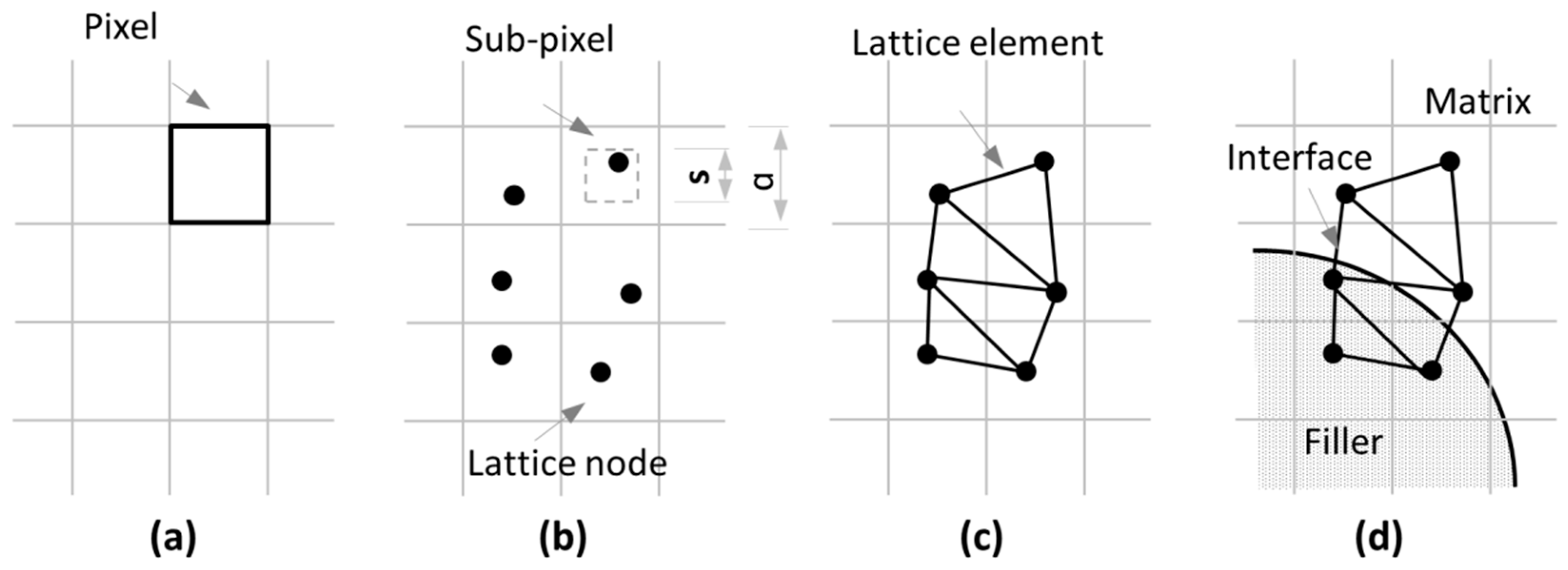
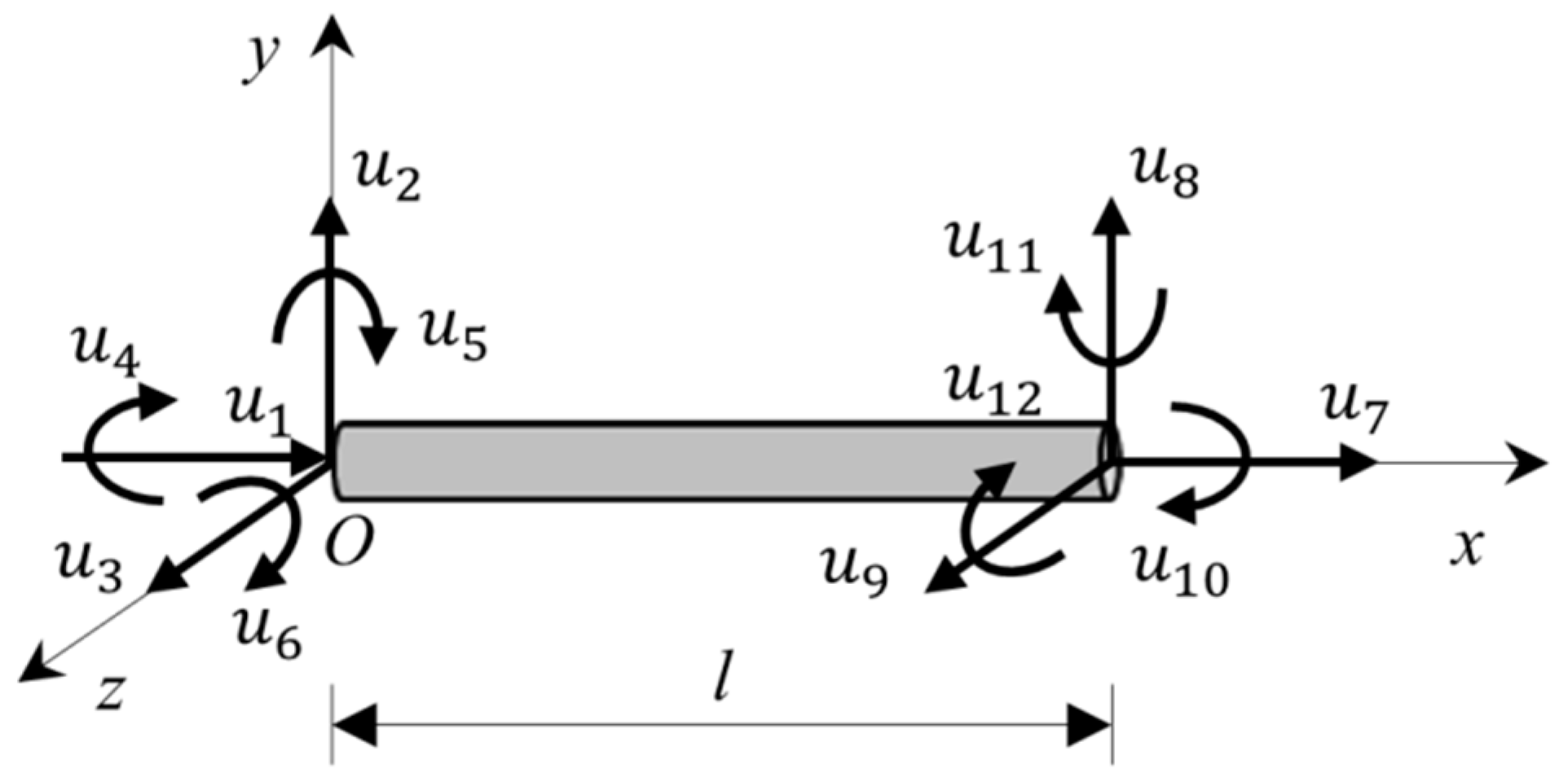
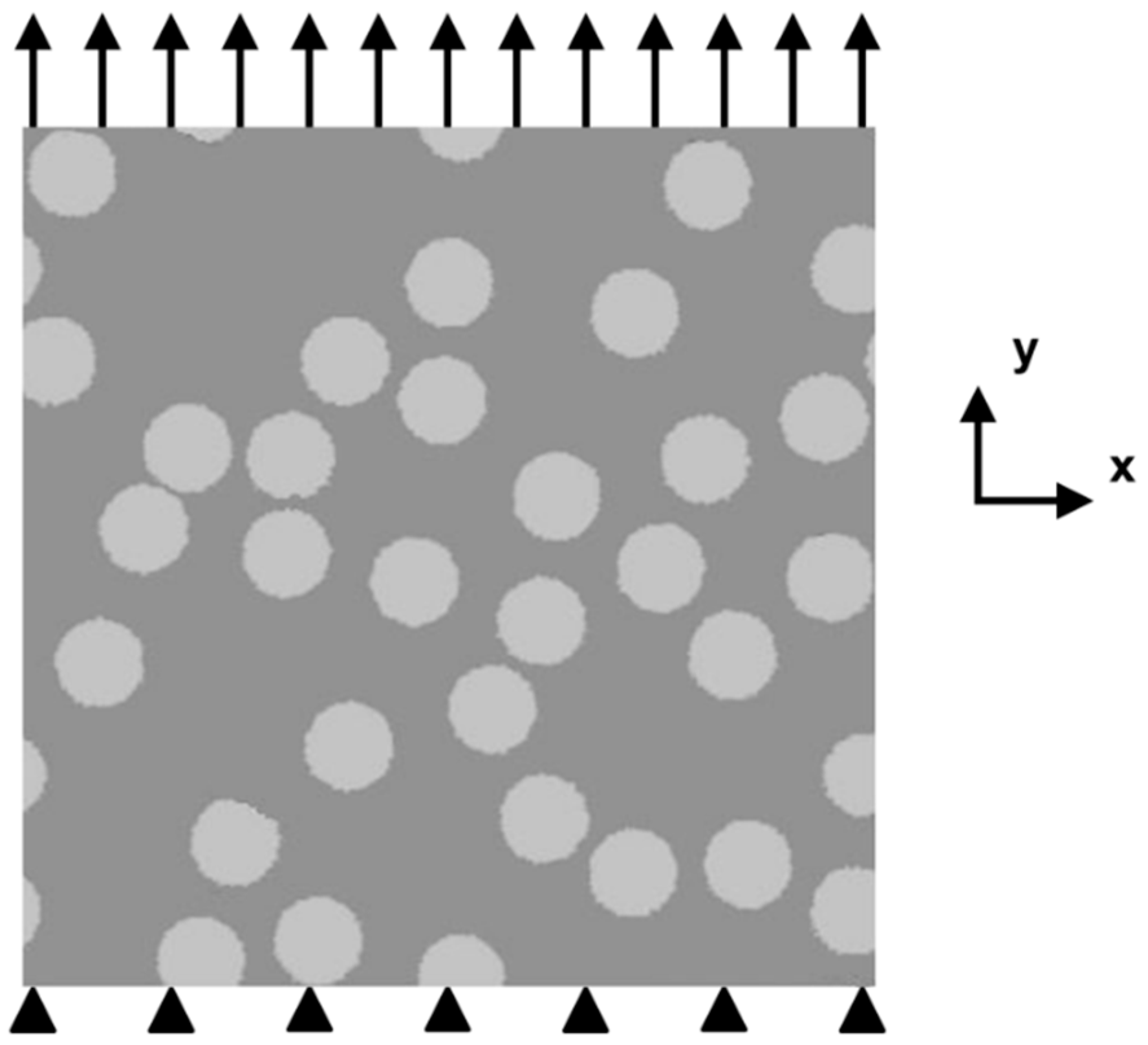
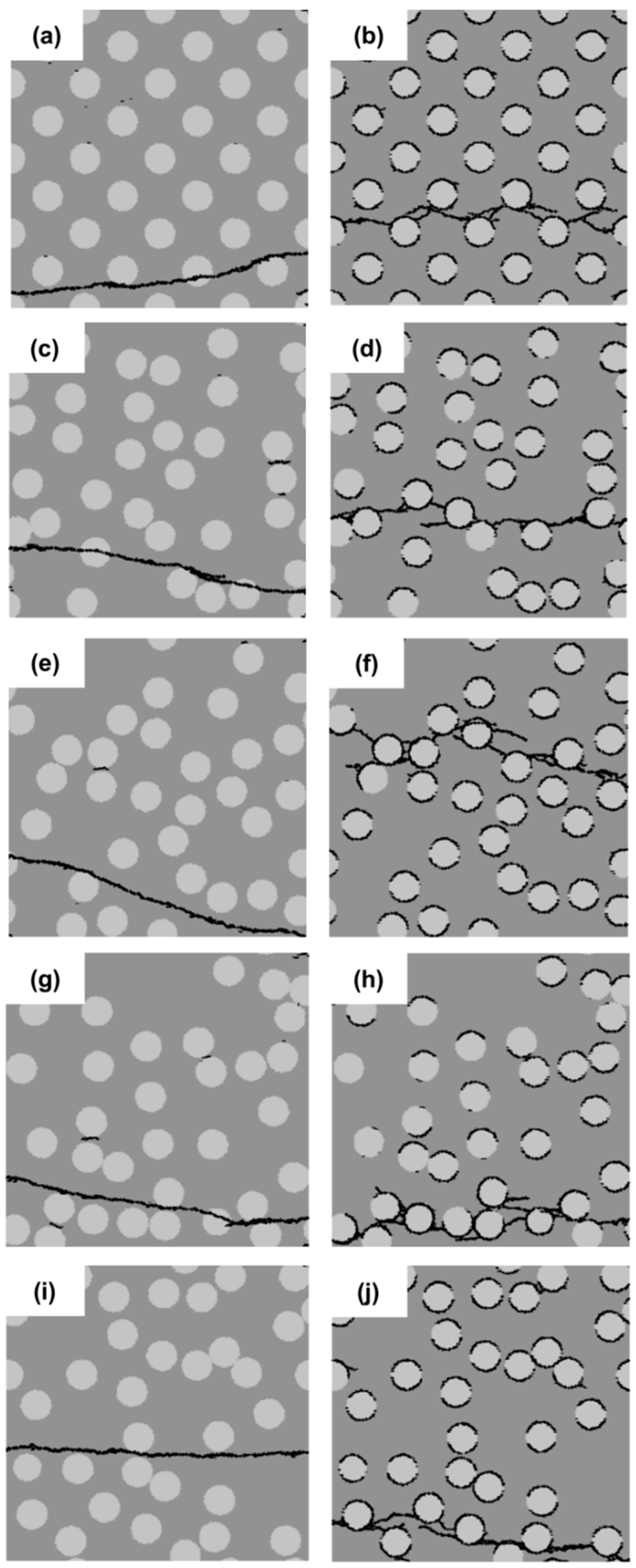
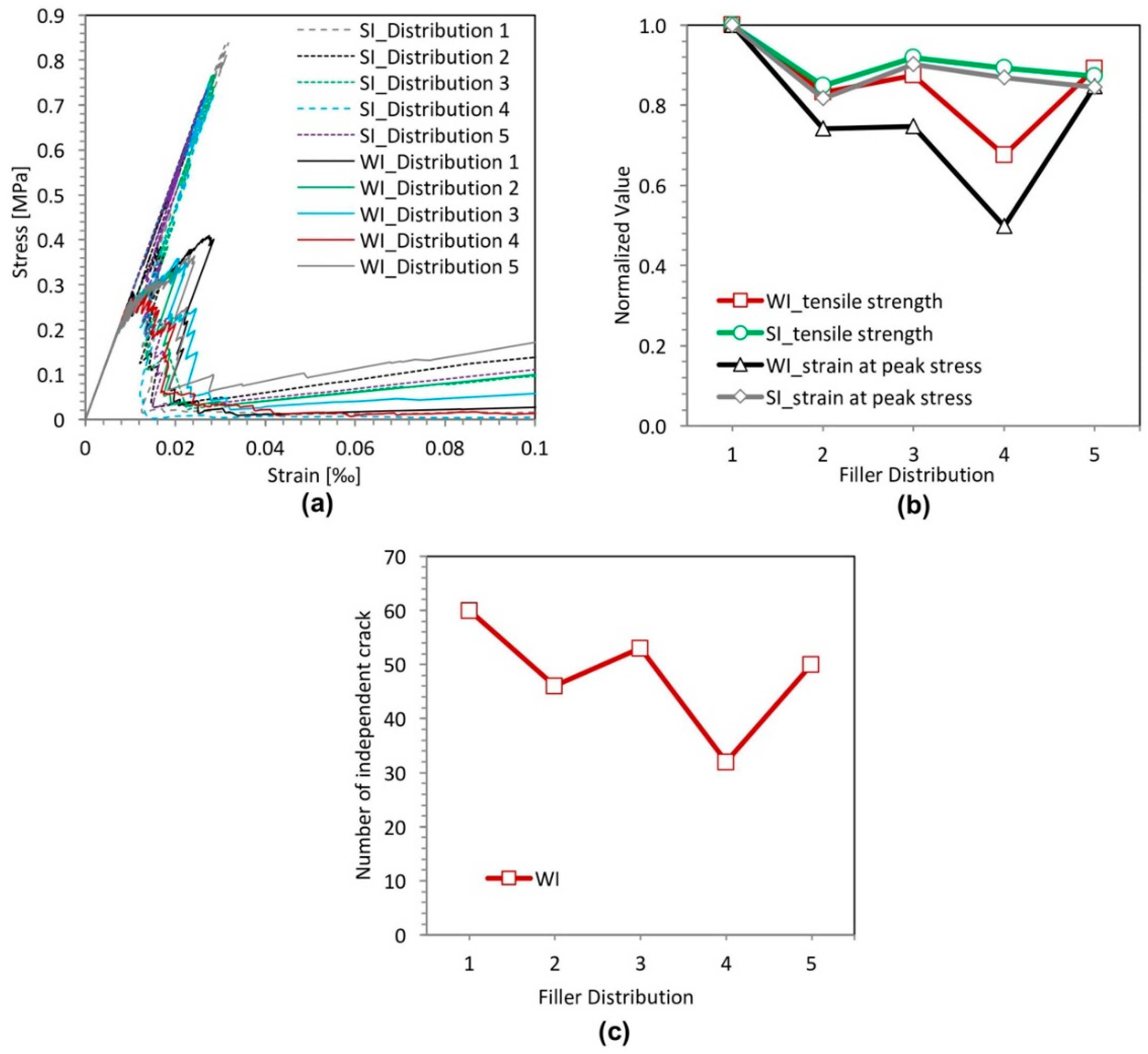
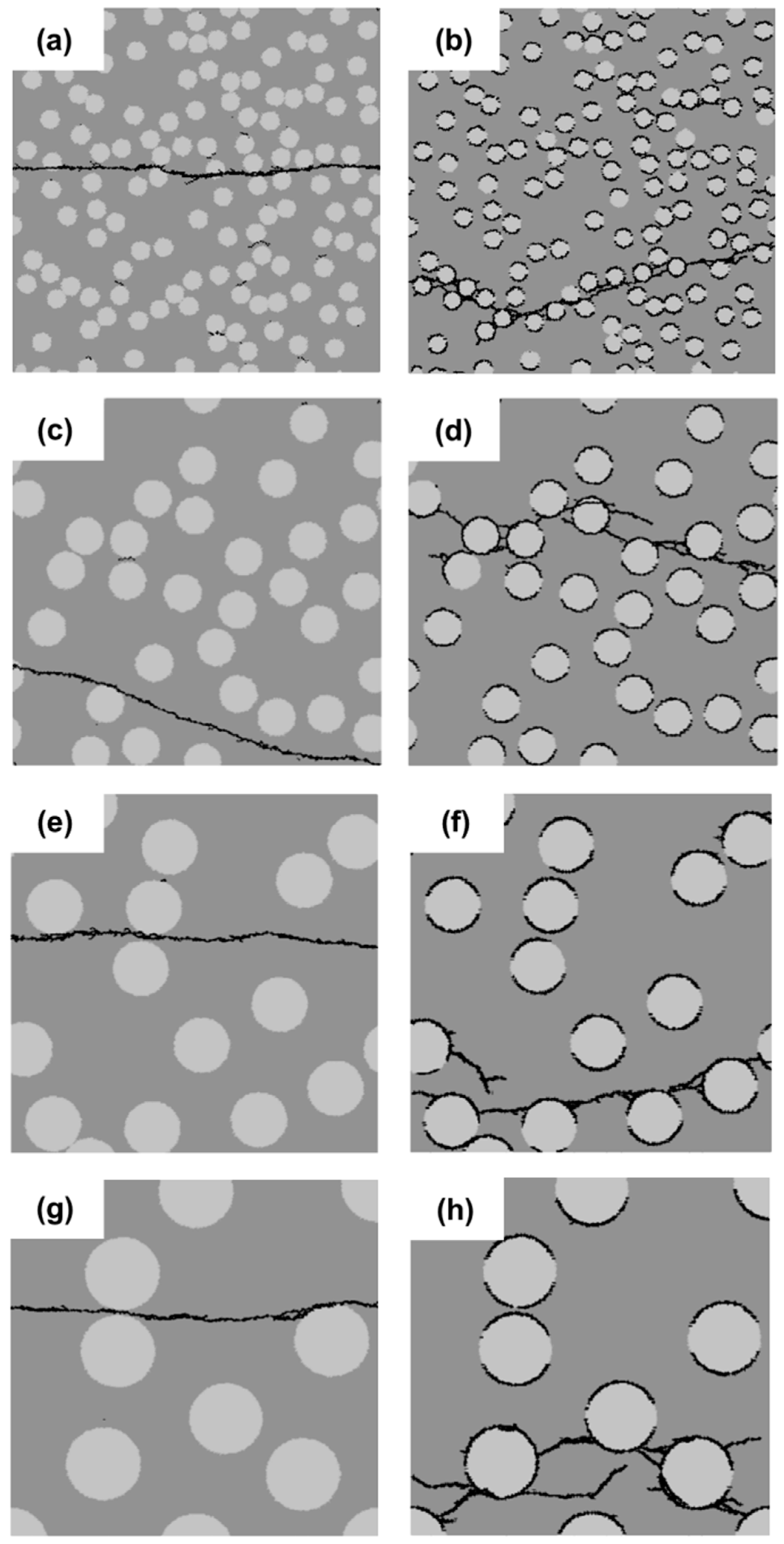
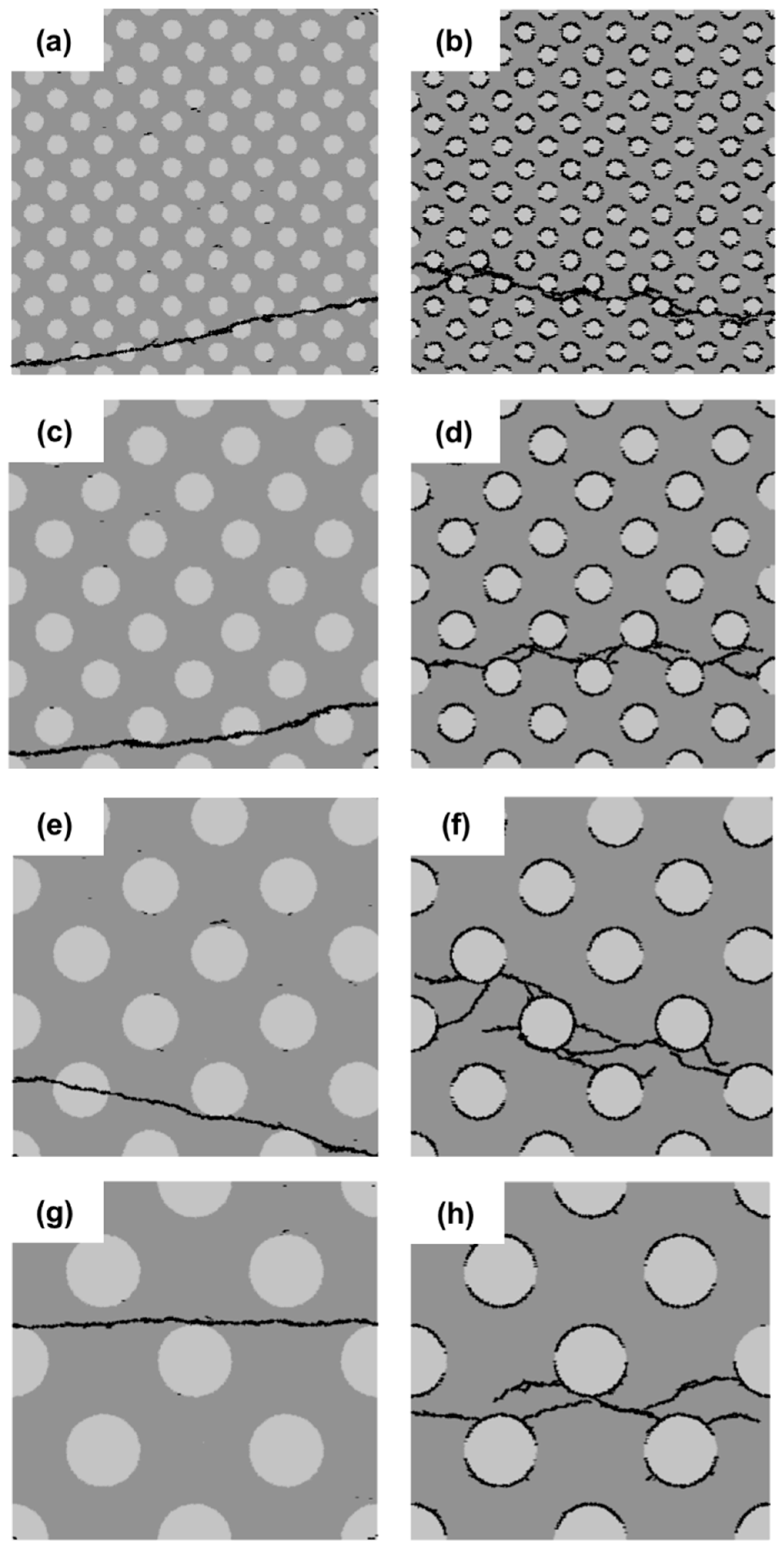
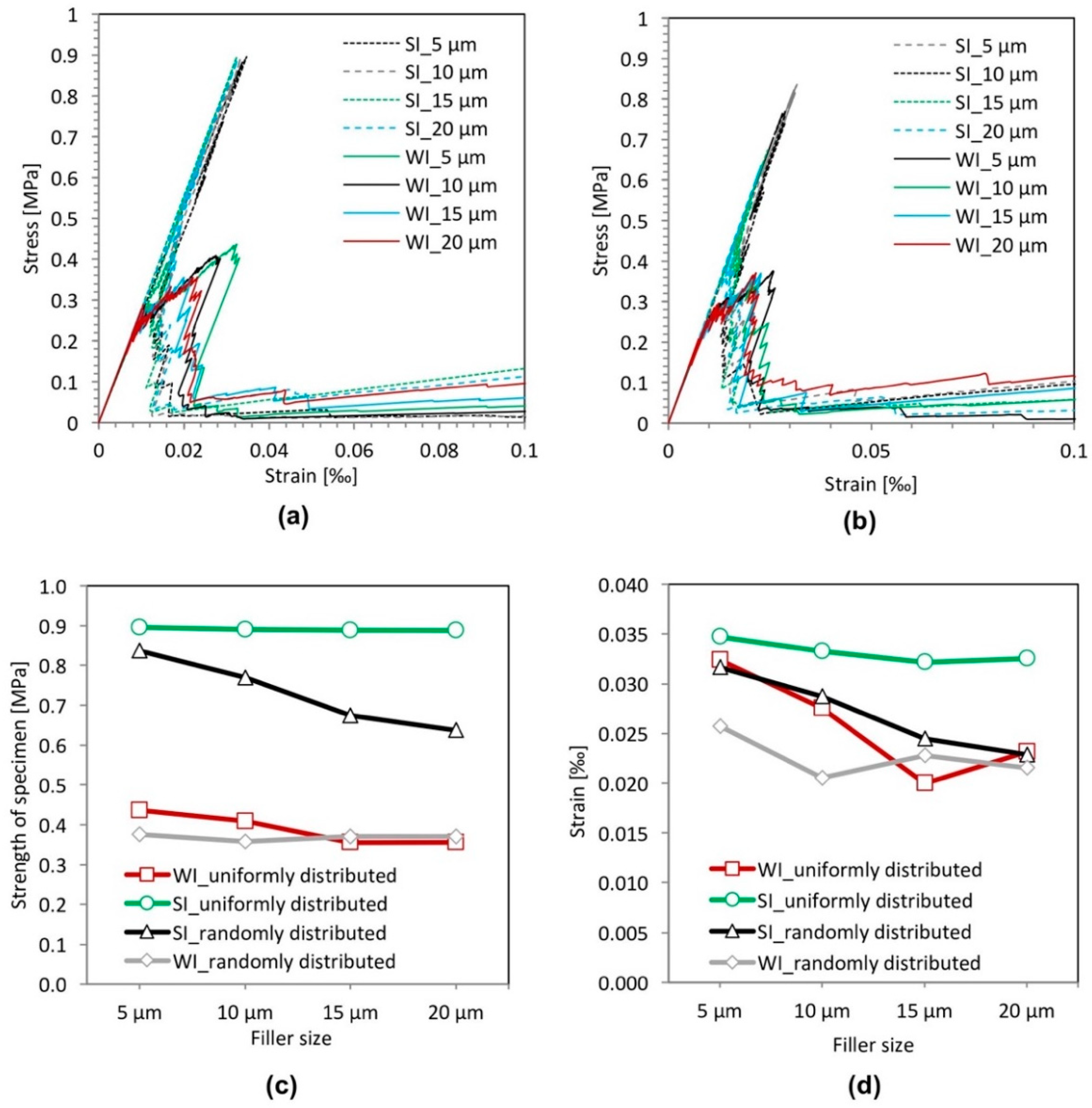
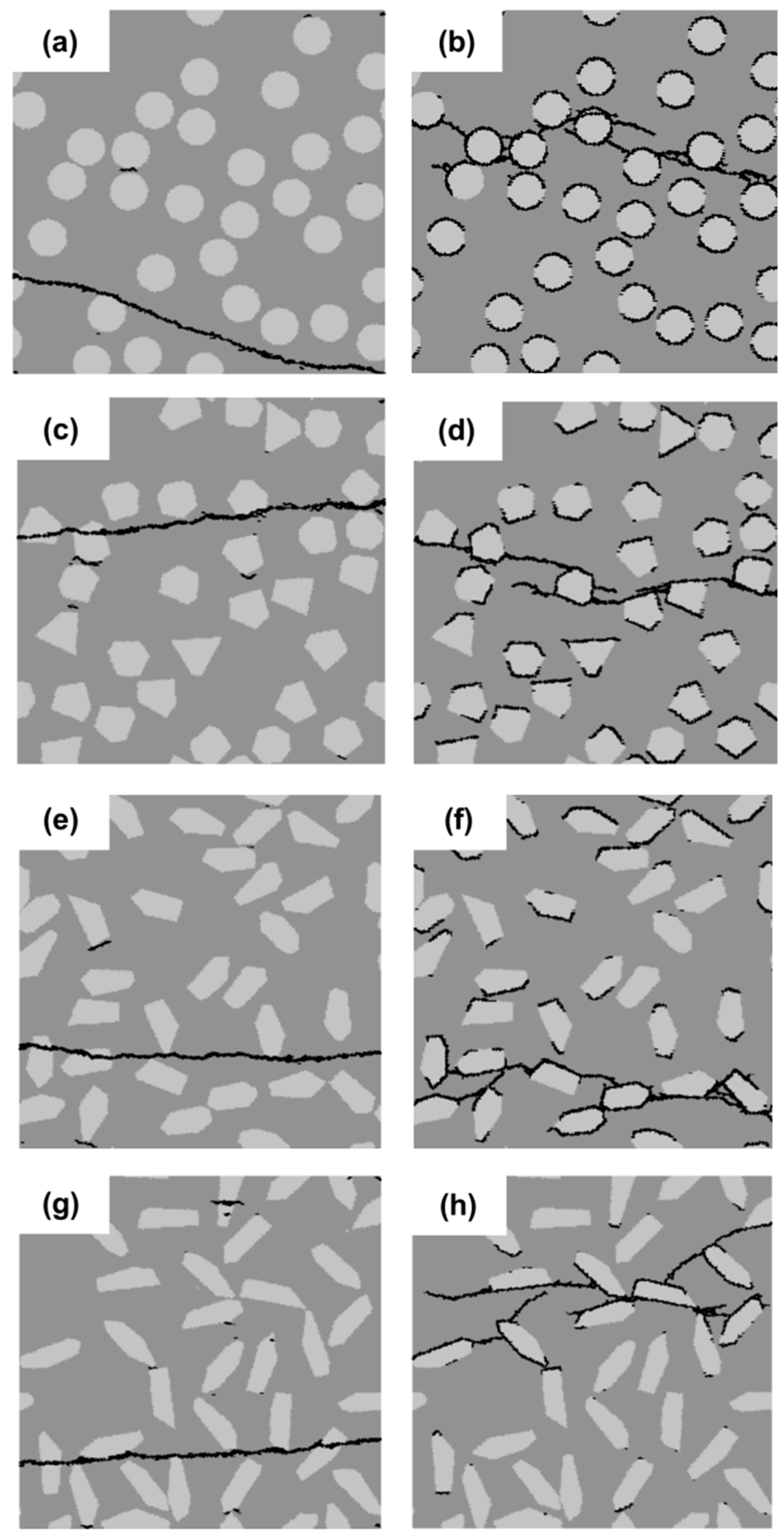
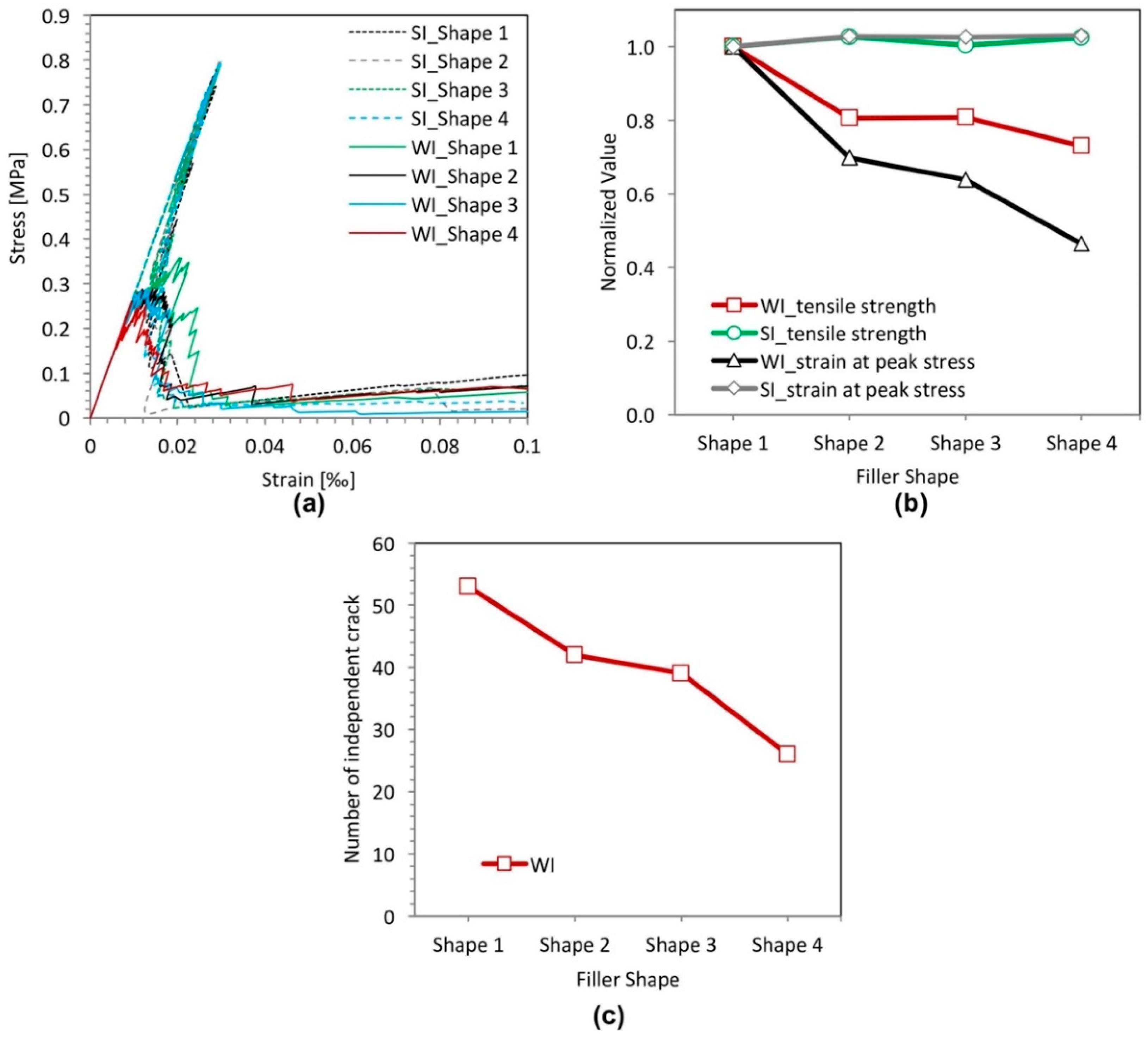
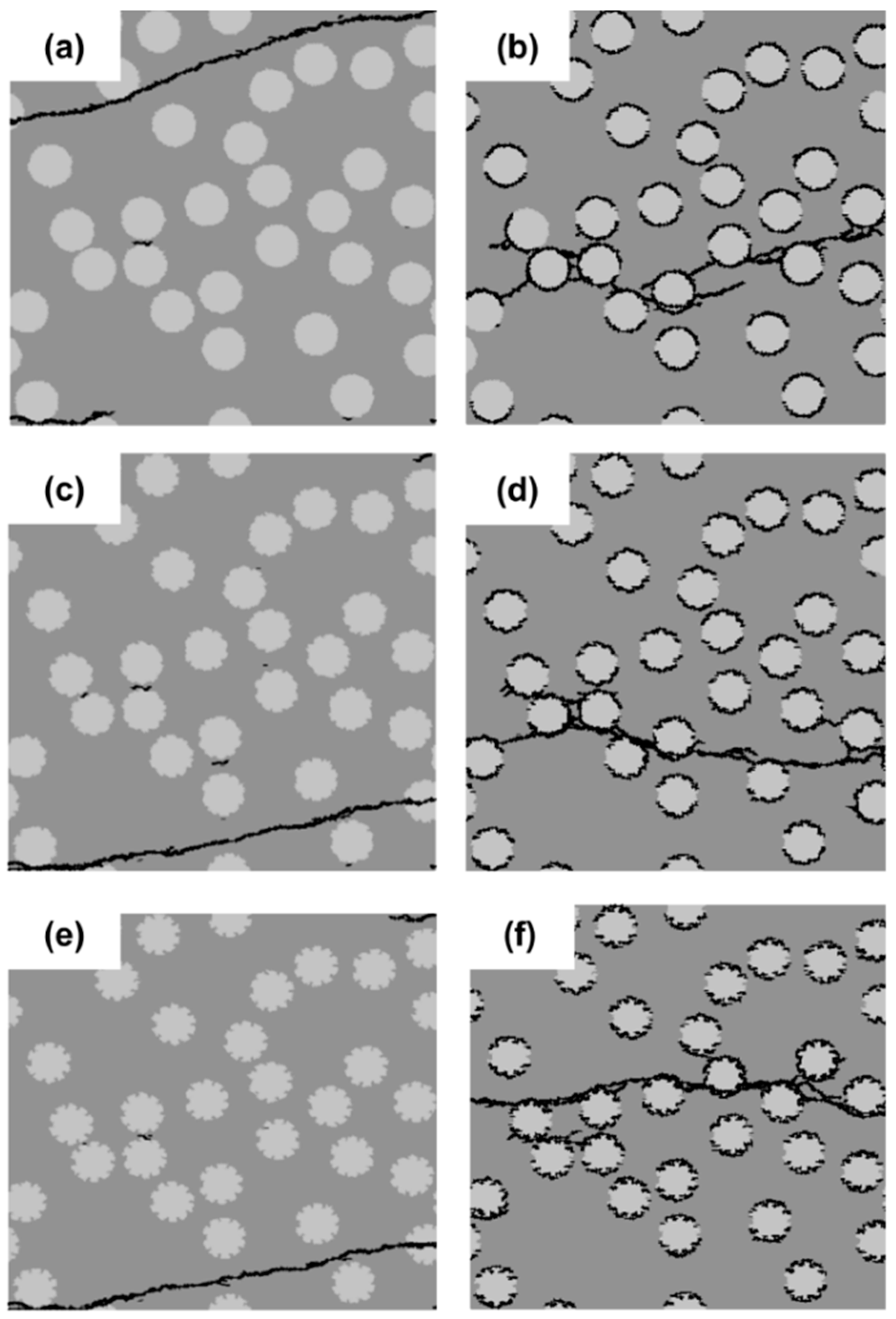
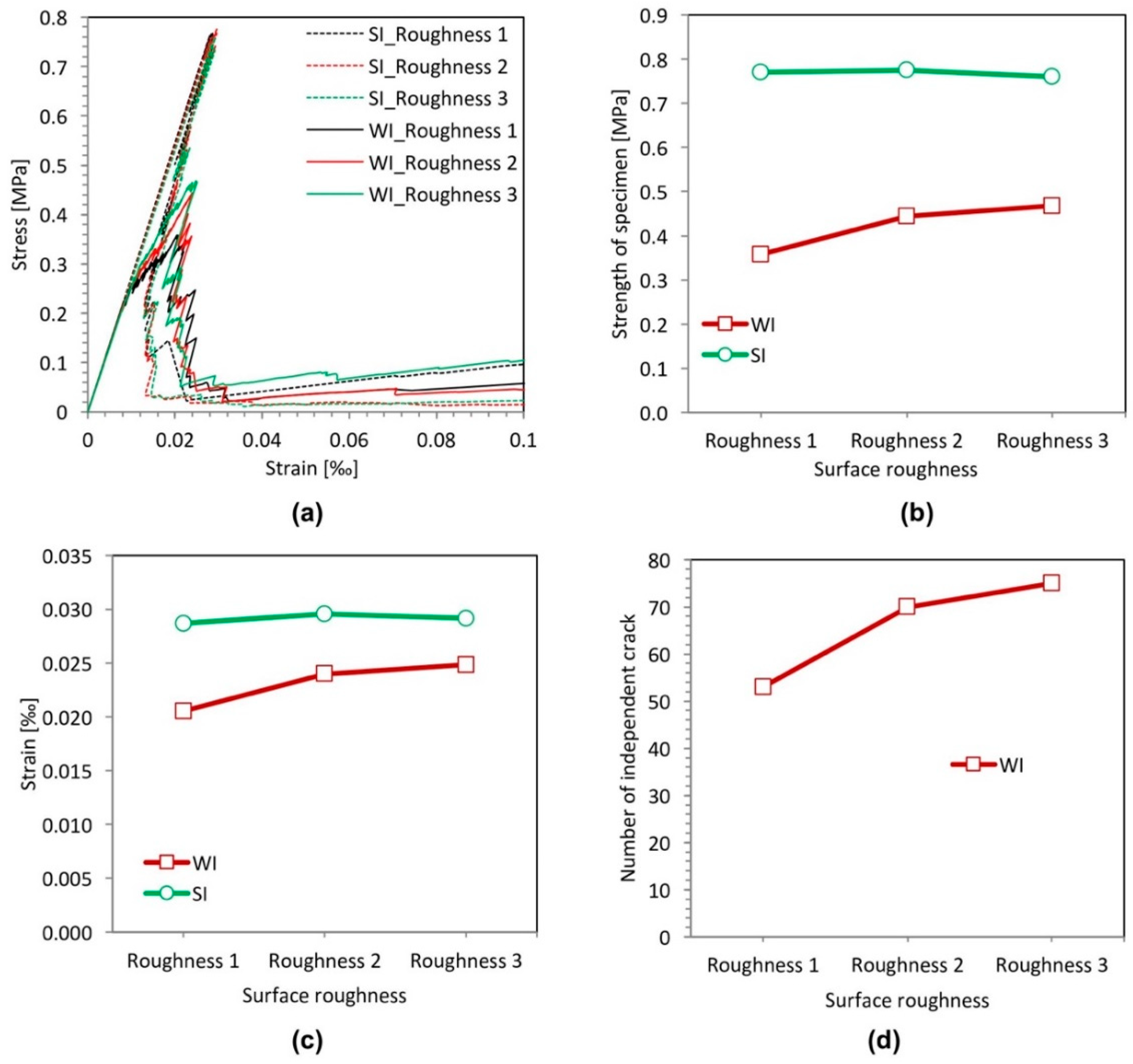
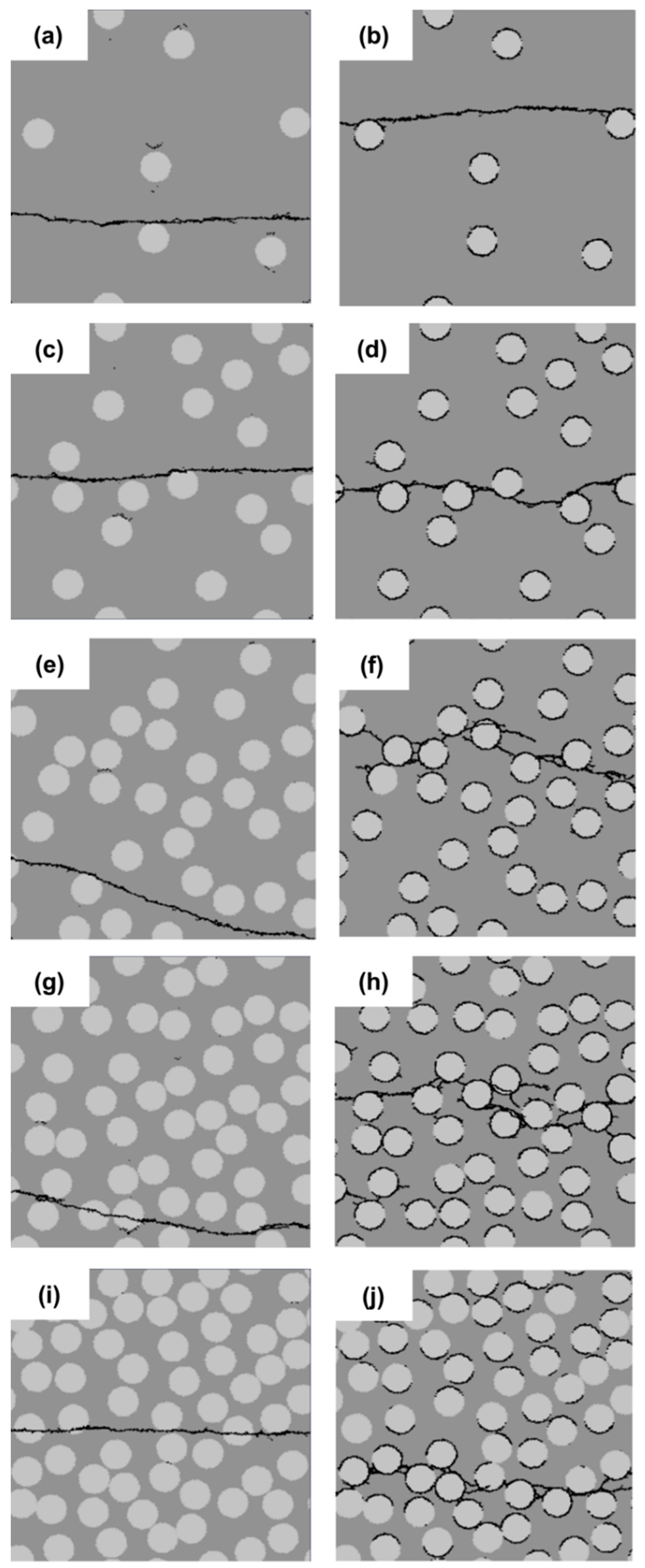
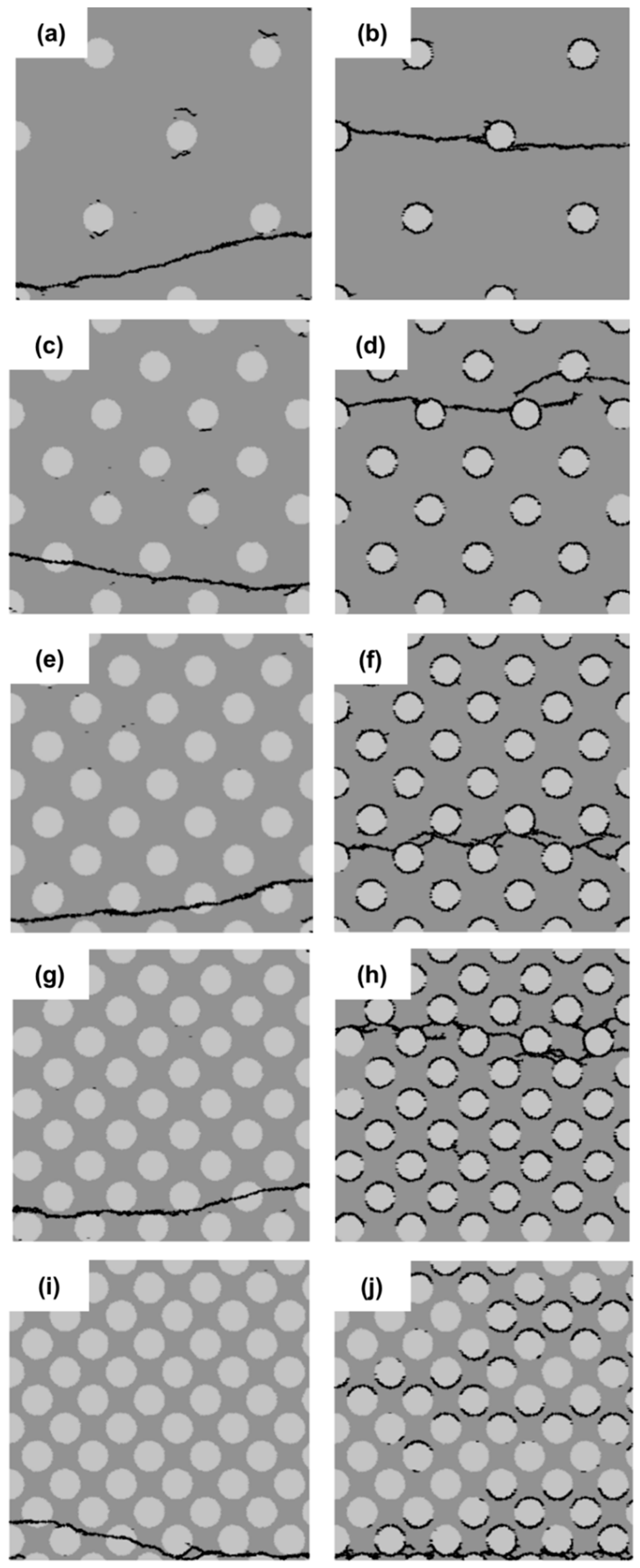
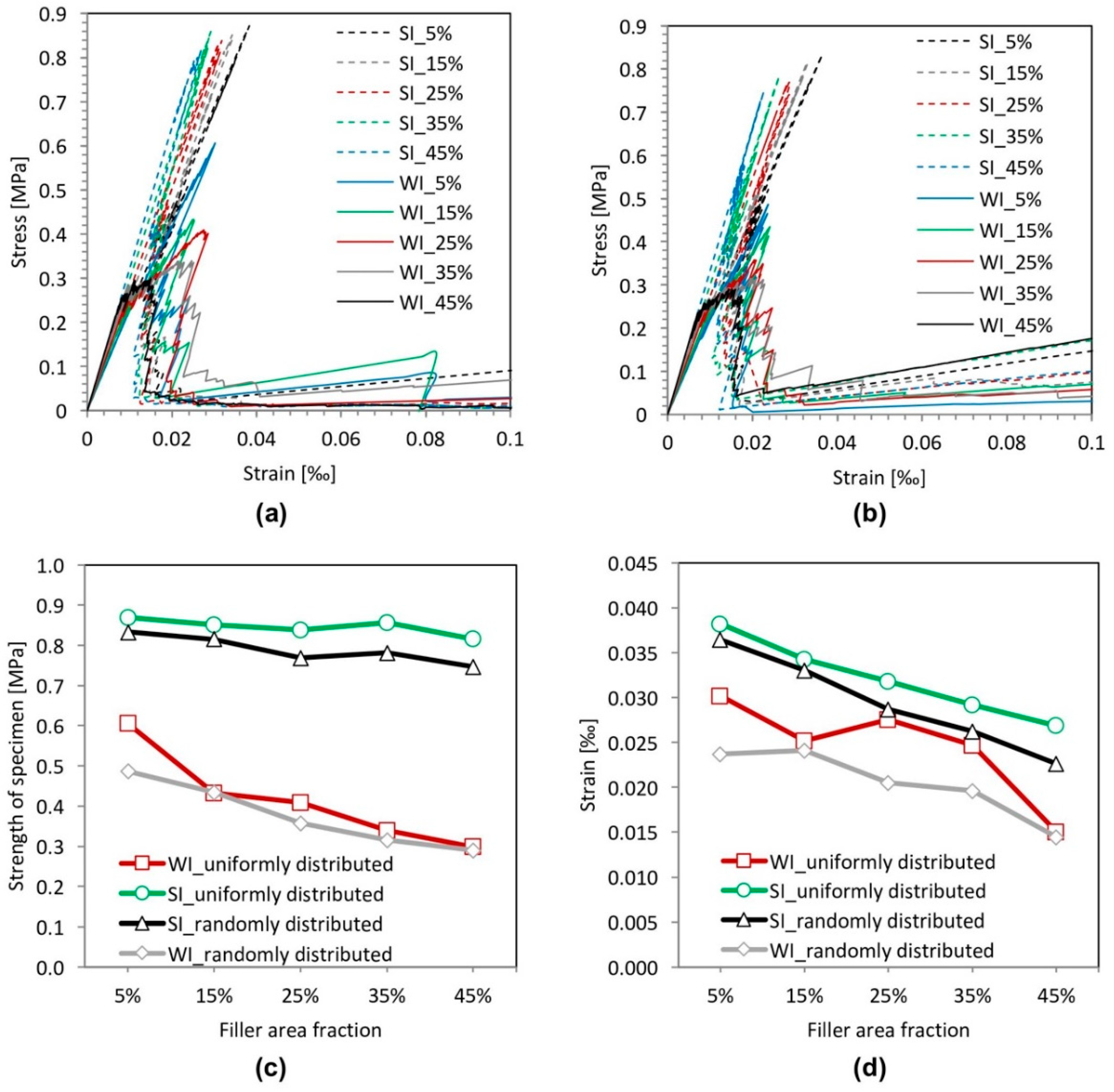
| Material Properties | Young′s Modulus E (GPa) | Tensile Strength ƒt (MPa) | ν |
|---|---|---|---|
| Filler | 71 | 2.1 | 0.2 |
| Matrix | 22 | 1.4 | 0.2 |
| Strong interface (SI) | 17 | 1.4 | 0.2 |
| Weak interface (WI) | 17 | 0.4 | 0.2 |
© 2018 by the authors. Licensee MDPI, Basel, Switzerland. This article is an open access article distributed under the terms and conditions of the Creative Commons Attribution (CC BY) license (http://creativecommons.org/licenses/by/4.0/).
Share and Cite
Ouyang, X.; Pan, Z.; Qian, Z.; Ma, Y.; Ye, G.; Van Breugel, K. Numerical Modelling of the Effect of Filler/Matrix Interfacial Strength on the Fracture of Cementitious Composites. Materials 2018, 11, 1362. https://doi.org/10.3390/ma11081362
Ouyang X, Pan Z, Qian Z, Ma Y, Ye G, Van Breugel K. Numerical Modelling of the Effect of Filler/Matrix Interfacial Strength on the Fracture of Cementitious Composites. Materials. 2018; 11(8):1362. https://doi.org/10.3390/ma11081362
Chicago/Turabian StyleOuyang, Xiaowei, Zichao Pan, Zhiwei Qian, Yuwei Ma, Guang Ye, and Klaas Van Breugel. 2018. "Numerical Modelling of the Effect of Filler/Matrix Interfacial Strength on the Fracture of Cementitious Composites" Materials 11, no. 8: 1362. https://doi.org/10.3390/ma11081362
APA StyleOuyang, X., Pan, Z., Qian, Z., Ma, Y., Ye, G., & Van Breugel, K. (2018). Numerical Modelling of the Effect of Filler/Matrix Interfacial Strength on the Fracture of Cementitious Composites. Materials, 11(8), 1362. https://doi.org/10.3390/ma11081362






